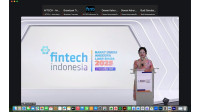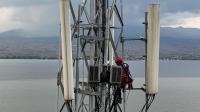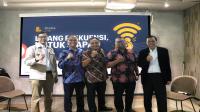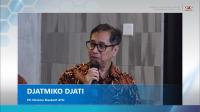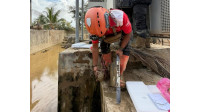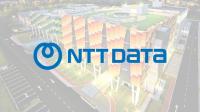Empowering Asia Pacific to get ahead in the digital economy
06:45:00 | 08 Jun 2022
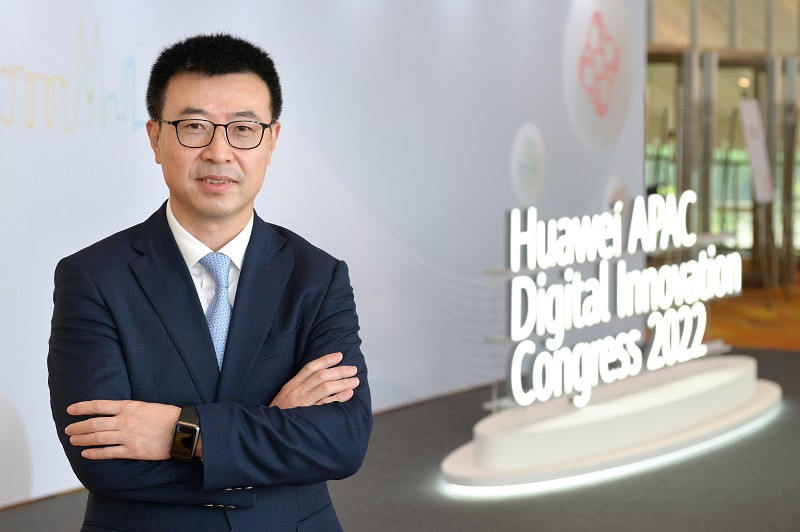
Photo Courtesy: The Edge
JAKARTA (IndoTelko) -- With more business activities resuming across the region, the International Monetary Fund forecasts Asia Pacific’s GDP to expand by 4.9% this year. However, that forecast can only become a reaality if businesses in the region reinvent themselves for the digital-first economy.
The Covid-19 pandemic has led employees and customers to increasingly expect businesses to be powered by a digital core. Research firm International Data Corp predicts that at least 65% of Asia Pacific’s GDP will be digitized this year, and one in three companies will generate more than 30% of their revenues from digital products and services by 2023.
Recognizing the region’s potential, Huawei has continually made significant investments to help businesses in Asia Pacific digitally transform to be more resilient and capture opportunities in the digital economy. “Under the mission of ‘In Asia Pacific, for Asia Pacific’, Huawei is committed to becoming a key contributor to the [region’s] digital economy,” said Simon Lin, president of Huawei Asia Pacific.
The region, he adds, is a strategic market for the company as most countries are showing determination to compete in the digital economy. They have developed clear policies and pushed out initiatives to get more local businesses to accelerate their digital transformation.
Pillars of the digital economy
Indeed, connectivity is the lifeblood of the digital economy. This is where Huawei can help.
“So far, we have provided connectivity for more than 90 million households and 1 billion mobile users in Asia Pacific. [We will continue to] help the region build a leading and green infrastructure, including 5G, broadband and data centers,” says Lin.
One way Huawei is doing so is by helping local telecommunications companies (telcos) to be more efficient. “[Leveraging our] deep understanding of telcos and their processes, we provide consultancy work to help them improve operational efficiency, investment efficiency, network planning efficiency, and more. [We are also helping some telcos] to modernize their existing networks using the latest technologies so that they can provide better customer experience and improve their energy efficiency,” he explains.
Besides connectivity, Lin notes that cloud computing and artificial intelligence (AI) are also major pillars of the digital economy.
With the cloud, organizations can gain access to cloud-enabled technologies and data faster, accelerating the pace of innovation. Meanwhile, AI can not only help enhance efficiency but also improve the speed and accuracy of decision-making.
Having a combination of the three will therefore empower organizations to address ever-changing business demands as well as find new business models and additional revenue opportunities.
“[For most, if not all, organizations,] digital transformation is not their target. Instead, they aim to create more or new value through their transformation efforts.
“For instance, a real asset management company that I recently spoke to shared what they hope to achieve from their digital transformation. Firstly, they are looking at ways to improve the customer experience for smart lighting, smart asset management and more. Secondly, they want to use digital energy to contribute to a greener, more sustainable society. Thirdly, they’re thinking of ways to expand their digital business like offering more digital services or going into e-commerce,” says Lin.
Helping businesses create new value
Priding itself as a customer-centric organization, Huawei does not only provide various technologies to its customers. More importantly, it works closely with organizations across industries in Asia Pacific to find business cases for emerging technologies, especially 5G.
This is exemplified in its multi-year partnership with Thailand’s Siriraj Hospital. Last December, they jointly launched a 5G Smart Hospital project, which aims to bring a more efficient and convenient experience to patients using technologies including 5G, cloud, and AI.
Additionally, Siriraj Hospital and Huawei will establish a Joint Innovation Lab to incubate and promote 30 5G medical applications this year. As of December 2021, both parties have started piloting 5G portable medical boxes, 5G unmanned vehicles, 5G medical carts, and 5G smart hospital beds.
“Siriraj Hospital is working with Huawei to develop new innovations and create new value by utilizing new digital technology. [We believe our efforts will] transform Siriraj Hospital into a role model for other public hospitals in Thailand. It will also act as a blueprint for all smart hospitals in Thailand going forward, [which in turn] will serve as a model for upgrading Thailand’s public health industry in the future,” Professor Prasit Watanapa MD, dean of the faculty of medicine for Siriraj Hospital at Mahidol University, tells delegates at the Mobile World Congress 2022.
Given its experience helping customers use technology in transformative ways, Lin adds that Huawei is best positioned to help organizations in Asia Pacific build business cases and equip them with best practices to adopt emerging technologies. This, in turn, may give traditional industries and conservative organizations the confidence to transform and capitalize on the digital economy.
He also shares that being customer-centric is not just a company slogan but also part of the company’s DNA.
To encourage and sustain that culture, he has baked that value into his team’s KPI (key performance indicator). For example, the local CEOs in Asia Pacific who report to him will be evaluated on both the 5G sales they bring in and how much customer value has been created, such as the number of use cases they have successfully enabled for each customer. Committed to taking Asia Pacific’s IT ecosystem forward Since thriving in the digital economy calls for the creative use of various technologies, it is not realistic to rely just on one vendor to become a digital-first organization. This is why Huawei is committed to building an open industry ecosystem with its partners and customers. According to Lin, Huawei has established partnerships with nearly 10,000 enterprise and cloud partners and 200 universities in Asia Pacific to date. This includes the 17 MoUs it signed with industry customers from Singapore, Malaysia, Thailand, Indonesia, and Bangladesh for smart campus, data center, digital power, and Huawei Cloud in May 2022.
The company also brings its global research and development (R&D) ability to the local market to innovate based on customer needs. “For example, we’ve built the Open Lab in Singapore and 5G Ecosystem Innovation Center (EIC) in Thailand. Currently, 5G EIC has gathered more than 100 partners to incubate 5G applications,” says Lin. To further help the region create new value, he adds that Huawei will be investing US$100 million ($137 million) in its Spark start-up program in Asia Pacific. Huawei has been helping Singapore, Hong Kong, Malaysia, and Thailand build their start-up hubs. The fund will therefore be used to develop four additional start-up hubs, namely in Indonesia, the Philippines, Sri Lanka, and Vietnam. The overall goal is to recruit 1,000 start-ups into the Spark accelerator program and shape 100 of them into scale-ups. Having people with the right skills is also crucial to succeed in the digital economy. As such, Huawei has pushed out various initiatives to help the workforce in the region to gain digital skills. Just last month, Huawei ICT Academy partnered with Singapore Polytechnic to launch an industry certification-based train and place course. Participants will learn the essential and fundamental skills in AI and cloud computing industries. They will be certified in five domains, including computer networking, Python programming, AI, cloud services and storage solutions. The knowledge gained will prepare them for the various job roles offered by Huawei and its solution partners. The program is open to fresh graduates or diploma holders in information technology, computer science, engineering, or other related fields with basic knowledge in cloud computing, computer systems, and networking. Applicants with qualifications outside of the specified fields will be considered on a case-by-case basis.
Besides that, Huawei announced in July 2021 that it will invest US$150 million ($205 million) in its Seeds for the Future Program 2.0 to develop digital talents over the next five years globally.
“Through the Huawei ASEAN Academy and Seeds for the Future, Huawei has worked with partners to train 170,000 local talents. In the next five years, we will continue to train 500,000 digital talents [to drive the region’s digital economy forward],” says Lin.
“Huawei wants to become a key contributor to Asia Pacific’s digital economy. This is why we want to establish a [digital] ecosystem [with our partners and customers, and] focus on digital talent cultivation. We also want to take more of our global R&D and localize for Asia Pacific to transfer more value [and help businesses here become digital-first],” he concludes.
Recognizing the region’s potential, Huawei has continually made significant investments to help businesses in Asia Pacific digitally transform to be more resilient and capture opportunities in the digital economy. “Under the mission of ‘In Asia Pacific, for Asia Pacific’, Huawei is committed to becoming a key contributor to the [region’s] digital economy,” said Simon Lin, president of Huawei Asia Pacific.
Baca juga :
•
•
•
To encourage and sustain that culture, he has baked that value into his team’s KPI (key performance indicator). For example, the local CEOs in Asia Pacific who report to him will be evaluated on both the 5G sales they bring in and how much customer value has been created, such as the number of use cases they have successfully enabled for each customer. Committed to taking Asia Pacific’s IT ecosystem forward Since thriving in the digital economy calls for the creative use of various technologies, it is not realistic to rely just on one vendor to become a digital-first organization. This is why Huawei is committed to building an open industry ecosystem with its partners and customers. According to Lin, Huawei has established partnerships with nearly 10,000 enterprise and cloud partners and 200 universities in Asia Pacific to date. This includes the 17 MoUs it signed with industry customers from Singapore, Malaysia, Thailand, Indonesia, and Bangladesh for smart campus, data center, digital power, and Huawei Cloud in May 2022.
The company also brings its global research and development (R&D) ability to the local market to innovate based on customer needs. “For example, we’ve built the Open Lab in Singapore and 5G Ecosystem Innovation Center (EIC) in Thailand. Currently, 5G EIC has gathered more than 100 partners to incubate 5G applications,” says Lin. To further help the region create new value, he adds that Huawei will be investing US$100 million ($137 million) in its Spark start-up program in Asia Pacific. Huawei has been helping Singapore, Hong Kong, Malaysia, and Thailand build their start-up hubs. The fund will therefore be used to develop four additional start-up hubs, namely in Indonesia, the Philippines, Sri Lanka, and Vietnam. The overall goal is to recruit 1,000 start-ups into the Spark accelerator program and shape 100 of them into scale-ups. Having people with the right skills is also crucial to succeed in the digital economy. As such, Huawei has pushed out various initiatives to help the workforce in the region to gain digital skills. Just last month, Huawei ICT Academy partnered with Singapore Polytechnic to launch an industry certification-based train and place course. Participants will learn the essential and fundamental skills in AI and cloud computing industries. They will be certified in five domains, including computer networking, Python programming, AI, cloud services and storage solutions. The knowledge gained will prepare them for the various job roles offered by Huawei and its solution partners. The program is open to fresh graduates or diploma holders in information technology, computer science, engineering, or other related fields with basic knowledge in cloud computing, computer systems, and networking. Applicants with qualifications outside of the specified fields will be considered on a case-by-case basis.
Artikel Terkait
-
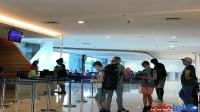 English Ver. - 04:06:00 | 25 Aug 2025The collaboration is designed to simplify complex payment processes for global travel businesses
English Ver. - 04:06:00 | 25 Aug 2025The collaboration is designed to simplify complex payment processes for global travel businesses -
 English Ver. - 04:07:00 | 11 Aug 2025Wireless Logic has completed the acquisition of Zipit Wireless
English Ver. - 04:07:00 | 11 Aug 2025Wireless Logic has completed the acquisition of Zipit Wireless -
 English Ver. - 05:00:00 | 27 Jul 2025JLL’s involvement included identifying and securing a site that met DAMAC’s technical and strategic requirements
English Ver. - 05:00:00 | 27 Jul 2025JLL’s involvement included identifying and securing a site that met DAMAC’s technical and strategic requirements
Rekomendasi
Berita Pilihan
More Stories
PR Newswire








.jpeg)

